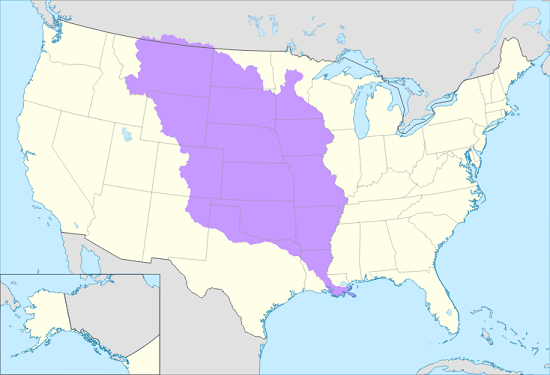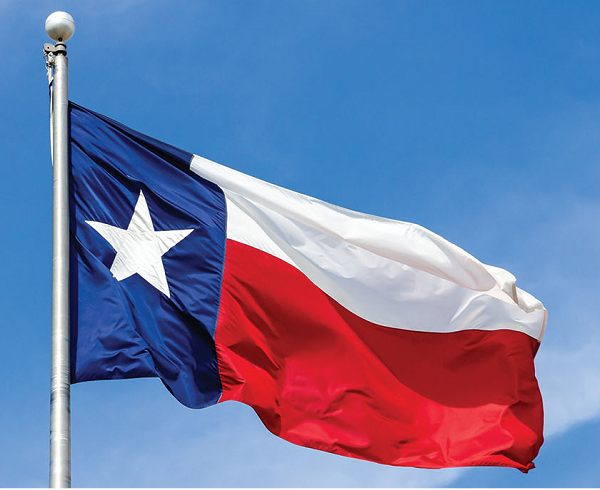LONE STAR AMERICA
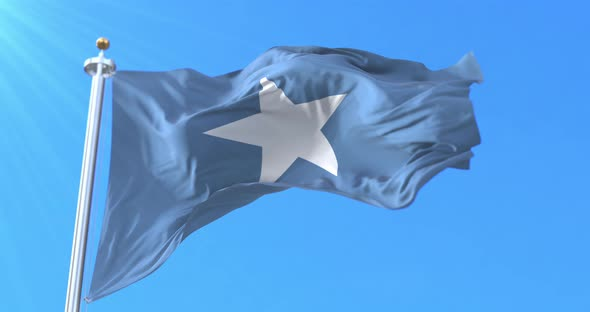 [This Monday’s Archive was originally published on December 27, 2006. Our situation is vastly worse now after The Treason of Biden organized an invasion of illegals in the tens of millions, and the Dems with their treasonous judges doing everything to block Trump’s efforts to remigrate them. Here’s a history lesson that couldn’t be more relevant today.]
[This Monday’s Archive was originally published on December 27, 2006. Our situation is vastly worse now after The Treason of Biden organized an invasion of illegals in the tens of millions, and the Dems with their treasonous judges doing everything to block Trump’s efforts to remigrate them. Here’s a history lesson that couldn’t be more relevant today.]
TTP December 27, 2006
I’m in a small town called St. Francisville in an obscure part of Louisiana. Visitors who come here stop briefly to gaze at the nicely preserved 19th century homes on its main street before hurrying off to the area’s principal attractions nearby – magnificent ante-bellum plantation mansions like Rosewood, the Myrtles, or Oakley where Audubon stayed and painted many of his birds.
Almost no tourists pay any attention to a flag that flies in front of the courthouse along with the stars and stripes and the state flag, nor have any idea what it symbolizes. You see it above.
It’s the Bonnie Blue flag of the Republic of West Florida, the capital of which was here. In 1810, St. Francisville was the capital of an independent country.
How it got to be, and what it may mean for America’s future, is a story that goes from Spanish explorers to American rebels, from Napoleon to the Alamo, from the “Halls of Montezuma” of the Marine Hymn to the current invasion of America by illegal aliens from Mexico.
So curl up and get cozy in your favorite chair while I tell you the story. It starts with a man named Hernando de Soto (1497-1542).
He was a Spanish conquistador with dreams of finding gold in an unexplored land called La Florida (Flower Land). For three whole years – 1539-1542 – he led a band of his countrymen wandering aimlessly through thousands of miles of what is the Southeast US, discovering no gold, only a huge river the Ojibwe Indians called the Mississippi (Great River).
Before he died on its banks at age 45, he claimed all the land he went through for Spain. Other than establishing a garrison town at St. Augustine (south of Jacksonville on Florida’s Atlantic coast) and a handful of tiny Catholic missions, the Spanish did nothing with it.
French explorer René-Robert Cavelier, Sieur de La Salle (1643-1687), was far more successful. In 1682, via the Great Lakes and the Illinois River, he canoed down the entire length of the Mississippi to the Gulf of Mexico. He claimed “all lands drained” by the great river for France, naming the territory La Louisiane in honor of King Louis XIV. It was gigantic:

La Louisiane – French Louisiana 1720
By 1699, the French had founded the town of Biloxi, by 1702 Mobile, by 1718 New Orleans. Colonists were arriving and the towns growing – but then the French lost the Seven Years War (known to us as the French and Indian War, 1756-1763).
In the Treaty of Paris of 1763, France ceded all of “New France” (French Canada) and Louisianne east of the Mississippi to England. All of Louisianne west of the Mississippi went to England’s ally, Spain, which then traded Florida to England for Havana, Cuba, captured by the British during the war.
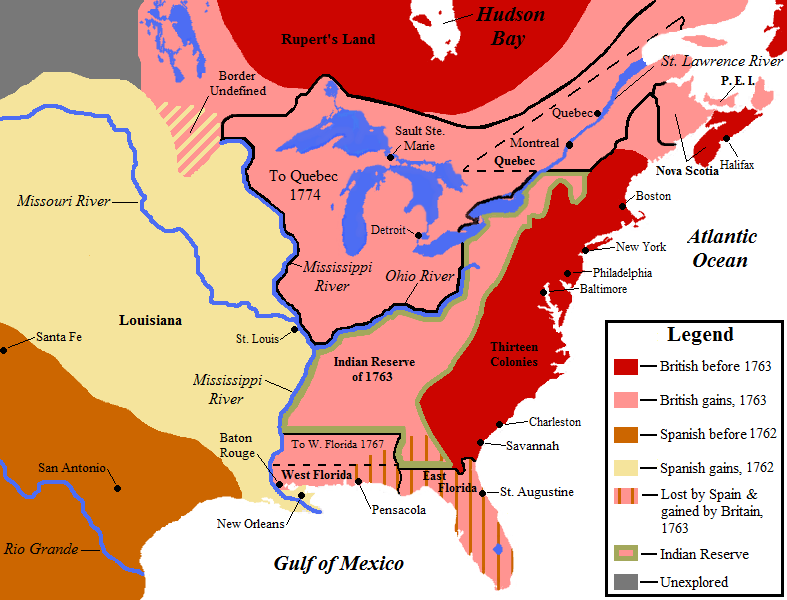
Results of the 1763 Treaty of Paris
England called French Florida (Louisianne along the Gulf of Mexico east of the Mississippi) “British West Florida” with Pensacola the capital. The rest was named British East Florida with St. Augustine the capital.
During the Revolutionary War, British Loyalists (“Tories”) poured into East and West Florida, especially the latter – for while Georgia and inland Alabama/Mississippi had revolted against King George, the Floridas did not.
Spain took advantage of this by having its Governor of Louisiana (Spanish respelling), Bernardo de Galvez lead successful assaults on Baton Rouge and Natchez in 1779, Mobile in 1780, and Pensacola in 1781, recapturing West Florida for Spain.
Thus in the Treaty of Paris of 1783, the British not only recognized the sovereign independence of the United States of America, they returned both East and West Florida to Spain.
Get ready now, for history is about to get a little off-the-wall.
By 1800, the French Revolution had resulted in being taken over by Napoleon, who wanted Louisiana back for France. So he made a secret deal with the King Charles IV of Spain (actually with his wife Queen Maria Amelia and her lover Manuel de Godoy for Charles was retarded) to trade (a “retrocession”) all of Louisiana for control of Tuscany in Italy. It was called the Treaty of Ildefonso.
President Thomas Jefferson’s spies in Paris found out about it in 1801, and that Napoleon needed some fast cash. He had lost his cash cow of Haiti and its sugar exports in a rebellion and might be open to a deal over Louisiana. The negotiations were concluded on May 2, 1803: 828,000 square miles for $15 million, or about three cents an acre. The Louisiana Purchase.
It was a lot of land – but it didn’t include Florida. Spanish Florida, with its panhandle extending all the way past Pensacola and Mobile to Baton Rouge and the Mississippi River, wasn’t part of the Ildefonso retrocession and thus not a part of the Louisiana Purchase.
Yet for 20 years since 1783, Spain had been offering irresistible land grants to American settlers, who had come in droves, particularly to the emerging cotton plantation region of West Florida north and east of Baton Rouge. Increasingly unhappy over Spanish rule and the US government’s unwillingness to antagonize Spain by supporting them, they looked for someone to lead them to independence.
They found him in a cousin of Thomas Jefferson’s with a name you couldn’t make up: Fulwar Skipwith (1765-1839). He had fought at Yorktown, appointed America’s Consul-General in Paris, been instrumental in negotiating the Louisiana Purchase, and married into European royalty. In 1809, he and his wife, the Baroness Thereze Josephine van den Clooster of Flanders, established themselves in a plantation near St. Francisville.
By June of 1810, the American settlers and plantation owners had appointed delegates to a constitutional convention that began regular meetings, and organized a militia led by an experienced soldier, Philemon Thomas. In the early morning hours of September 23, Thomas and his militia seized by armed force the Spanish garrison at Baton Rouge.
Raising the Bonnie Blue flag, they declared the establishment of the Free and Independent Republic of West Florida. Over the next few days, the delegates convened a legislature with a Senate and House of Representatives, adopted a constitution based on America’s. and elected a President: Fulwar Skipwith. The Republic’s capital was declared to be St. Francisville.
The Republic, comprised of these present-day counties in Louisiana, Mississippi, and Alabama (note – none in Florida!) –
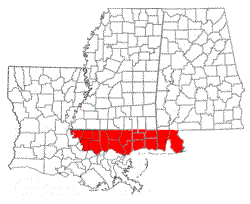
was short-lived. By November, President James Madison declared West Florida to be part of the Louisiana Purchase (although Skipwith could prove it wasn’t) and authorized its annexation. By December, 1810, US possession was taken of St. Francisville and Baton Rouge peacefully, without a shot fired. Ex-president Skipwith retired to his plantation. The portion of the Republic in Louisiana is to this day known as the Florida Parishes.
Spain contested the annexation, and now challenged the legality of the entire Louisiana Purchase, claiming France had no right to sell it and never owned it anyway, since the secret Ildefonso treaty was invalid.
But by now, a war of independence from Spain had begun in Mexico. Spain could not hope to contain this rebellion and continue territorial disputes with the US. Thus in 1819, US Secretary of State John Quincy Adams and Spanish Foreign Minister Luis de Onis concluded the Adams-Onis Treaty, with the US paying $5 million for all of Florida and settling the US-New Spain border.
Take a good look at this map of the treaty:
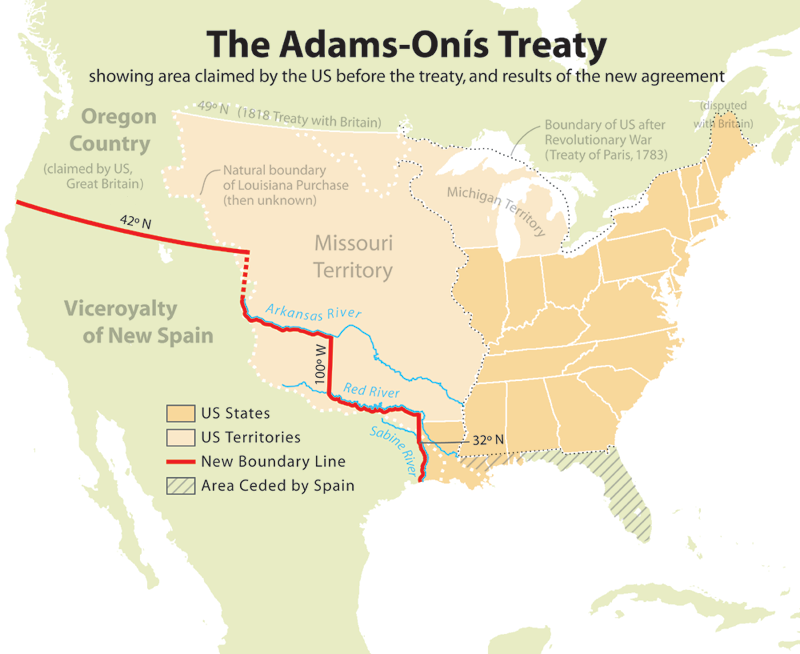
Note that Spain had once claimed the entire Pacific Northwest, which it ceded to the US as the Oregon Country. Note the Missouri Territory as comprising the Louisiana Purchase previously declared invalid by Spain.
For anyone concerned about the Reconquista threat from Mexico, this map should cause goose-bumps. It’s not just about the 1848 Treaty of Guadalupe Hidalgo anymore.
The Reconquistas are after far more than just California, Texas, and the Southwest US. They claim that in addition the Pacific Northwest, the Missouri Territory, Louisiana and Florida were stolen by the US and rightfully belong to Mexico.
And right now as you are reading this, the Democrats are colluding with a number of Republicans in both the House and Senate to provide amnesty and citizenship to close to 20 million illegal aliens from Mexico.
One of most famous heroes to die at the Alamo on March 6, 1836 was Jim Bowie. Legendary frontiersman and inventor of the Bowie Knife, he had spent most of his life in Louisiana. He grew up with the stories of the West Florida revolt, and when he brought a band of Louisianans with him to fight at the Alamo, they came flying the banner of the Bonnie Blue Flag.
As the battle was raging at the Alamo, a convention at Washington-on-the-Brazos on March 2 issued the Texas Declaration of Independence and announced that Texas was a sovereign nation free of Mexico. The first elected president of the Republic of Texas was David Burnet.
Burnet had lived in Louisiana before coming to Texas, knew Bowie, and knew what flag Bowie had died under at the Alamo. So he designed a flag for the Texas Republic – a copy of the Bonnie Blue with red and white added for a patriotic Red White & Blue.
The Lone Star of Texas originated in St. Francisville, Louisiana.
The Bonnie Blue Lone Star is the symbol of independence and the willingness to fight for it. And specifically freedom and independence from Spain and Mexico. It is time for it to be raised again over all of America. For our country has been invaded by an army numbering in the millions. Are we going to let them dismember our country without a struggle?
I wish this story had a good ending. Maybe it will, for history hasn’t written the ending yet.
But in the Museum of National History in Mexico City, there is an enormous map in the entrance foyer depicting Mexico Integral – Greater Mexico, Mexico Integrated and Whole. Every class of students on a field trip from their school to the museum is made to sit down and gaze up at the huge map, while the teacher explains how so much of Los Estados Unidos was stolen from Mexico and really belongs to them.
For when Mexico achieved its independence from Spain, it renounced all the treaties signed by Spain ceding territory as invalid. Every Mexican schoolchild is taught they are illegal.
One final irony is that Mexico’s Museum of National History is in Chapultepec Castle. It was here on the morning of September 13, 1847 that a group of Marines led by Captain Silas Casey stormed the castle walls. After its capture, the Marines called Chapultepec Castle “The Halls of Montezuma.”
The First Mexican-American War of 1846-48 was conducted quickly and won decisively. We are now in an undeclared Second Mexican-American War. So far it has been conducted slowly – but it could be lost decisively. The first decisive step towards that loss would be the passage of the Amnesty Bill now being prepared in Congress.
Will Americans who don’t want to see their country dismembered rise up under the Bonnie Blue Flag of Freedom and fight for a Lone Star America? One way to tell is to see how many rise up to oppose the Amnesty Bill.


